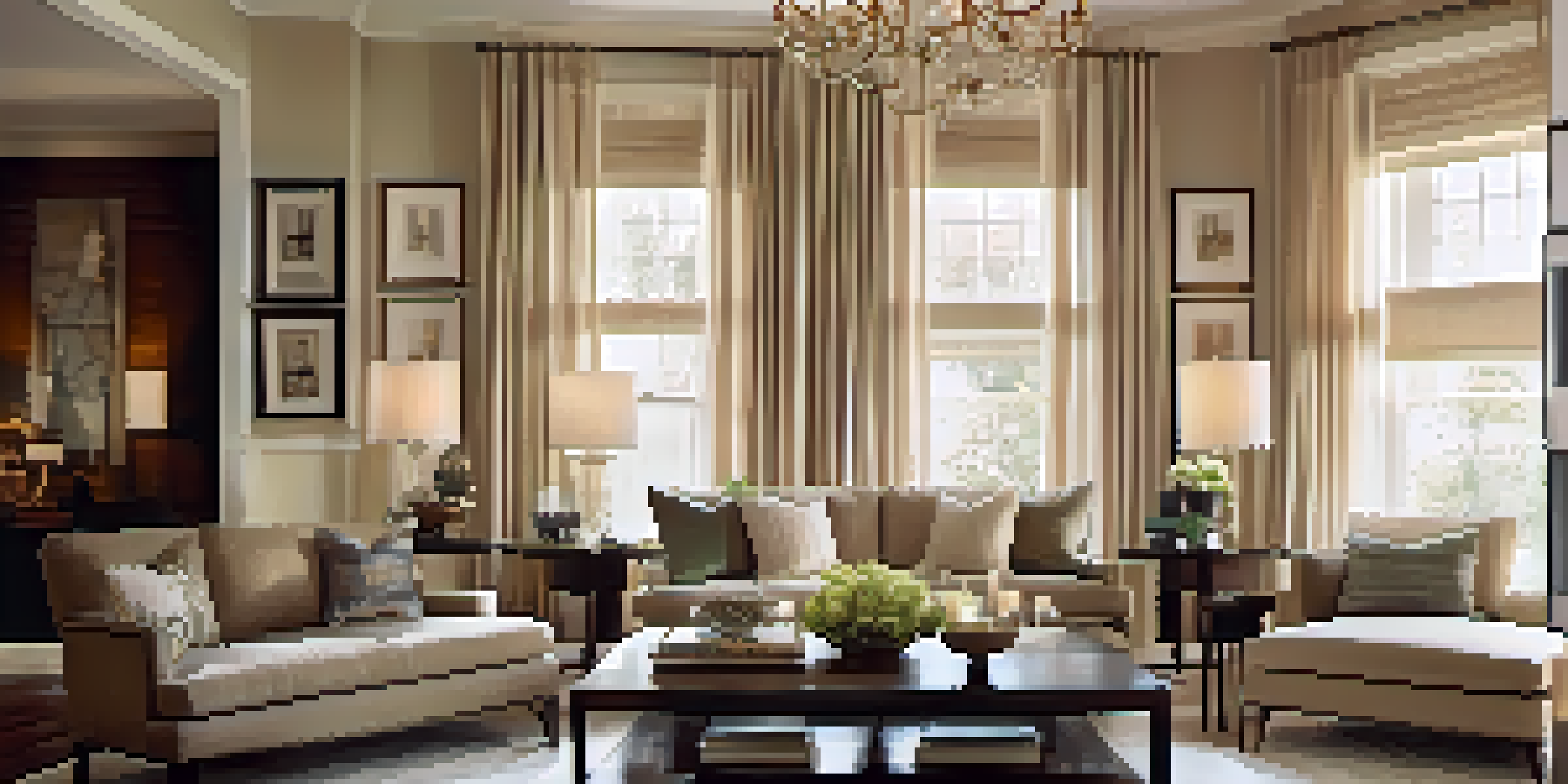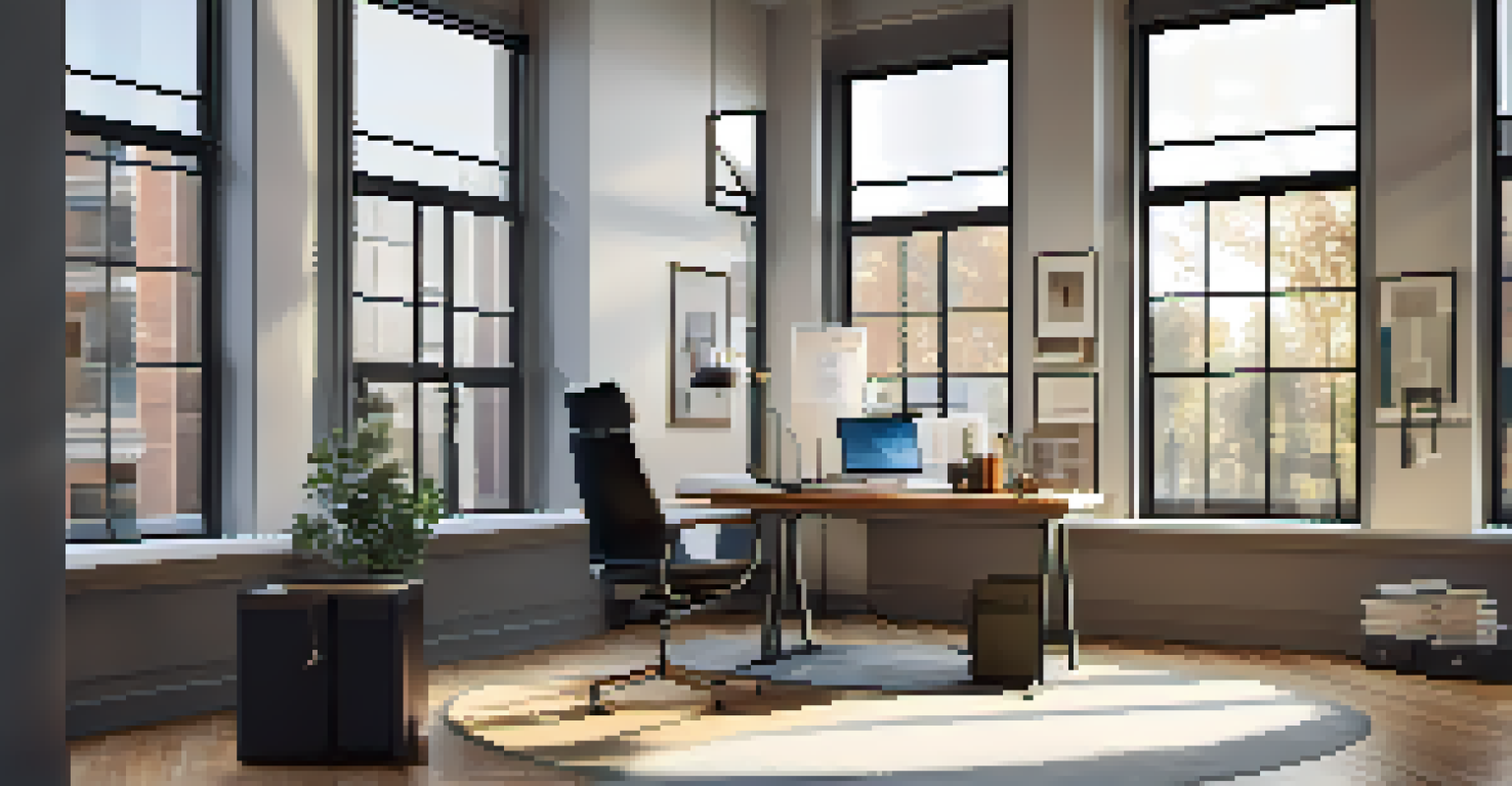Combining Different Lighting Types for Maximum Effect

Understanding the Three Main Types of Lighting
When it comes to lighting, there are three primary types to consider: ambient, task, and accent lighting. Ambient lighting provides the overall illumination in a space, setting the mood and ensuring visibility. Task lighting, on the other hand, focuses on specific areas where activities like reading or cooking occur, helping to enhance functionality.
Lighting is like the paintbrush of a room; it can create drama, emotion, and atmosphere.
Accent lighting serves to highlight features or create visual interest in a room, such as artwork or architectural details. By understanding these three types of lighting, you can start to see how they each play a role in creating a well-lit environment. Think of them as the trio of musicians in a band, each contributing to the harmony of your space.
Combining these types effectively can lead to an inviting atmosphere that not only looks great but also functions well. So, let's dive deeper into how to mix and match these lighting types for maximum effect.
Creating a Layered Lighting Design
Layering lighting involves using multiple sources from the three types of lighting to create depth and dimension in a room. For example, in a living room, you might have an overhead chandelier for ambient light, table lamps for task lighting, and wall sconces for accent lighting. This approach adds richness and character to your space.

A well-layered design also allows you to adjust the mood of the room based on the time of day or activity. Imagine hosting a dinner party; you could dim the overhead lights and turn up the accent lights to highlight your beautiful table setup. Layering gives you flexibility and control over your environment.
Types of Lighting Explained
Understanding ambient, task, and accent lighting is essential for creating a well-lit and functional space.
To achieve a balanced layered effect, consider the height and placement of each light source. This thoughtful arrangement can transform even the simplest of rooms into a stunning visual experience.
Choosing the Right Bulb for Each Lighting Type
The type of bulb you choose plays a crucial role in how each lighting layer performs. For ambient lighting, soft white bulbs create a warm, inviting atmosphere, perfect for relaxation. In contrast, task lighting often benefits from brighter, cooler bulbs that enhance visibility and focus.
The best lighting is the one that makes you feel at home.
When it comes to accent lighting, you might opt for LED or halogen bulbs, which provide a concentrated beam to effectively highlight your focal points without overwhelming the space. Each bulb type contributes differently to the overall ambiance, so selecting the right one is key to achieving your desired effect.
Remember that the color temperature of the bulb can also influence the mood. Warmer lights tend to create a cozy feeling, while cooler tones can make a space feel modern and energizing. Take time to experiment with different bulbs to find the perfect match for each lighting type.
Positioning Lights for Optimal Impact
The placement of your lighting can significantly affect its efficacy. For ambient lighting, ceiling fixtures should be centrally located to provide even light distribution throughout the room. This ensures that no corner is left in the dark, promoting a welcoming environment.
Task lighting should be positioned to minimize shadows and glare. For instance, a desk lamp should be placed to the side of your work area, illuminating your tasks without obstructing your view. Proper positioning can make a world of difference in functionality and comfort.
Layering for Visual Depth
Combining different lighting types can enhance the atmosphere and functionality of a room, offering flexibility for various activities.
Accent lighting requires a bit more finesse. Tilting a spotlight towards artwork or using a wall wash can create stunning visual effects. By thoughtfully considering where each light source is placed, you can enhance the overall aesthetic and functionality of your space.
Utilizing Dimmers for Versatile Lighting
Dimmers are a fantastic addition to any lighting design, allowing you to adjust the brightness according to your needs. They can transform a bright, functional space into a soft, intimate setting with just a flick of a switch. This versatility is especially beneficial in multi-purpose rooms.
For example, in a dining area, you might want bright light for meal preparation but a softer glow for dining and conversation. Dimmers give you the control to create the perfect atmosphere, making your space feel more dynamic. It's like having a mood ring for your home.
Additionally, using dimmers can extend the lifespan of your bulbs by reducing their energy output. This eco-friendly choice not only saves you money on your electric bill but also contributes to a more sustainable lifestyle.
Incorporating Natural Light with Artificial Lighting
Natural light is one of the most beautiful sources of illumination, and it can work harmoniously with artificial lighting. Consider the direction of windows and how sunlight moves throughout the day to enhance your design. For example, using sheer curtains can allow natural light to filter in while providing a soft glow.
By strategically placing mirrors or reflective surfaces, you can amplify the natural light in a room, making it feel larger and more inviting. This combination of natural and artificial lighting can create a balanced, dynamic environment that changes throughout the day.
Impact of Bulb Choice
Selecting the right type of bulb is crucial as it influences the mood and effectiveness of each lighting layer.
Remember to adjust your artificial lighting according to the amount of natural light available. On bright days, you might want to rely less on overhead lights, while on gloomy days, you can boost your lighting to maintain a warm, inviting feel.
Experimenting with Color and Light Combinations
Color and light have an intricate relationship, and experimenting with different combinations can lead to stunning results. For instance, warm-colored walls paired with cool lighting can create a striking contrast that adds depth to a room. Don't be afraid to play around with colors to find what works best for your space.
Additionally, colored bulbs or light filters can provide a fun way to enhance your lighting design. Whether it's a soft blue for a calming bedroom or vibrant hues for a lively entertainment space, the right colors can evoke specific moods and feelings.

Keep in mind that the way colors interact with light can change throughout the day. Observing how light affects your chosen colors will help you make informed decisions that align with your vision for the space.
Final Thoughts on Combining Lighting Types
Combining different lighting types is not just about illumination; it's about creating an experience. The right blend can evoke emotions, enhance functionality, and transform an ordinary space into something extraordinary. Embrace the idea of layering and experimenting with your lighting design.
As you begin to implement these strategies, remember that there's no one-size-fits-all approach. Each space is unique, and your personal style should shine through in your choices. Take your time to assess what works best for your needs and preferences.
Ultimately, the goal is to create a space that feels comfortable and reflects who you are. So, gather your lighting tools, let your creativity flow, and watch as your space comes to life!